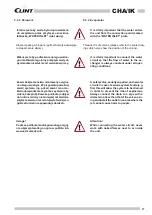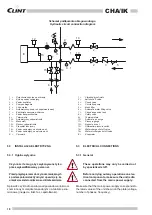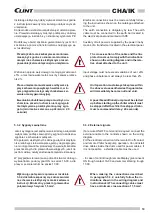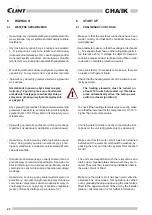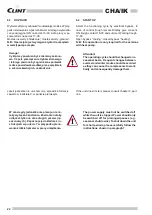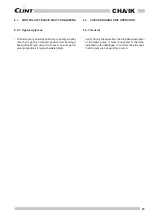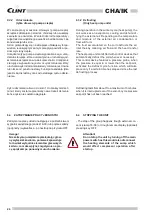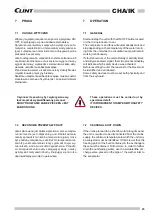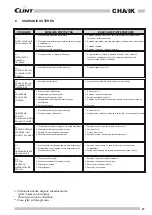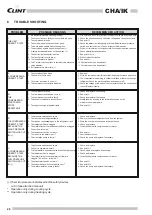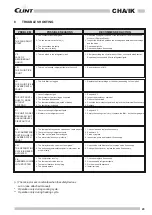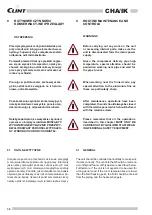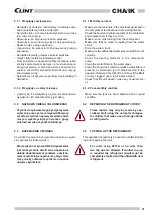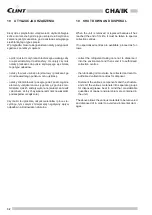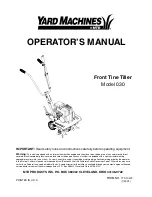
28
CHA/IK
(+) The microprocessor indicates when the safety devices
cut in (see attached manual).
* Operation only during cooling cycle.
** Operation only during heating cycle.
8
TROUBLE SHOOTING
1. Give off idraulic circuit, verify the right running of pumps and if valves are open
2. Check the phase sequence, check the voltage and close the contacts.
3. See point II.
4. Check the water circulation pump and the differential water pressure
switch, and vent the circuit. Check further external enables.
5. System on temperature, no cooling demand. Check adjustment and operation.
6. Check adjustment and operation.
7. See points IV or V.
8. Wait for about 5 minutes.
9. See point VI.
10. Contact the service department.
11. Contact the service department.
1. Replace.
2. Close the compressor circuit breaker after identifying the reason why it cut in.
3. The compressor was working in critical conditions or there isn't enough
refrigerant. Check the work conditions and see point VII.
4. Check the voltage at the ends of the contactor coil and the continuity of
the coil.Replace if faulty.
1. Check and replace if necessary.
2. See point V.
3. Check and replace if necessary.
4. Modify them by referring to the information shown on the
microprocessor programme.
5. See point VII.
1. Check and replace.
2. Remove the excess refrigerant liquid from the system.
3. Drain the circuit, pressurise and recharge the unit
4. Check and replace.
5. Clean the
filters
with compressed air or water.
6. See point VI.
7. Vent the water circuit.
8. Check the pump and replace if necessary.
1. Check and replace.
2. See point VII.
3. Check, clean and replace if necessary.
4. Check and replace.
5. Clean the
filters
with compressed air or water.
6. See point VI.
7. See point XIII.
8. Check the pump and replace if necessary
1. No differential pressure switch agreement
2. The connections are faulty or the contacts are open
3. The compressor's faulty
4. The external enables have not been given
5. The work probe enable has not been given
6. The antifreeze enable has not been given (+)
7. A safety device enable has not been given (+)
8. The anti-recirculation timer is active
9. The fan thermal cut-outs trip (+)
10. The inverter alarm is present.
11. The T- alarm is present (bus to communicate electronic
valve actuator)
12. Exit temperature alarm limit (+)
1. The compressor has blown
2. The power circuit is open
3. The motor protection is open (+)
4. The compressor contactor is disabled
1. The compressor's faulty
2. The low pressure switch has cut in (+)
3. The compressor contactor is faulty
4. The set-point values are incorrectly set
5. There's not enough refrigerant liquid
1. The pressure switch doesn't work
2. There's too much refrigerant liquid
3. There's non condensable gas in the refrigerant circuit
4. The refrigerant
filter
is clogged
5. The metal
filters
of the condenser (if
fitted)
are clogged.
The air
flow
is too low *
6. The condenser fans do not work *
7. There's air in the water circuit **
8. The circulation pump is faulty **
1. The pressure switch doesn't work
2. The unit is completely empty
3. The thermostatic expansion valve doesn't work properly
4. The refrigerant
filter
is clogged
5. The metal
filters
of the evaporator (if
fitted)
are
clogged. The air
flow
is too low **
6. The evaporator fans do not work **
7. The evaporating coil is covered with frost **
8. The water circulation pump is faulty *
I.
THE UNIT
DOESN'T START
II.
A COMPRESSOR
DOESN'T START
III.
THE
COMPRESSOR
STARTS AND
STOPS
REPEATEDLY
IV.
THE COMPRESSOR
DOESN'T START
BECAUSE THE
HIGH PRESSURE
SWITCH HAS CUT
IN (+)
V.
A COMPRESSOR
DOESN'T START
BECAUSE THE
LOW PRESSURE
SWITCH HAS CUT
IN (+)
PROBLEM
POSSIBLE REASONS
RECOMMEN DED ACTION




